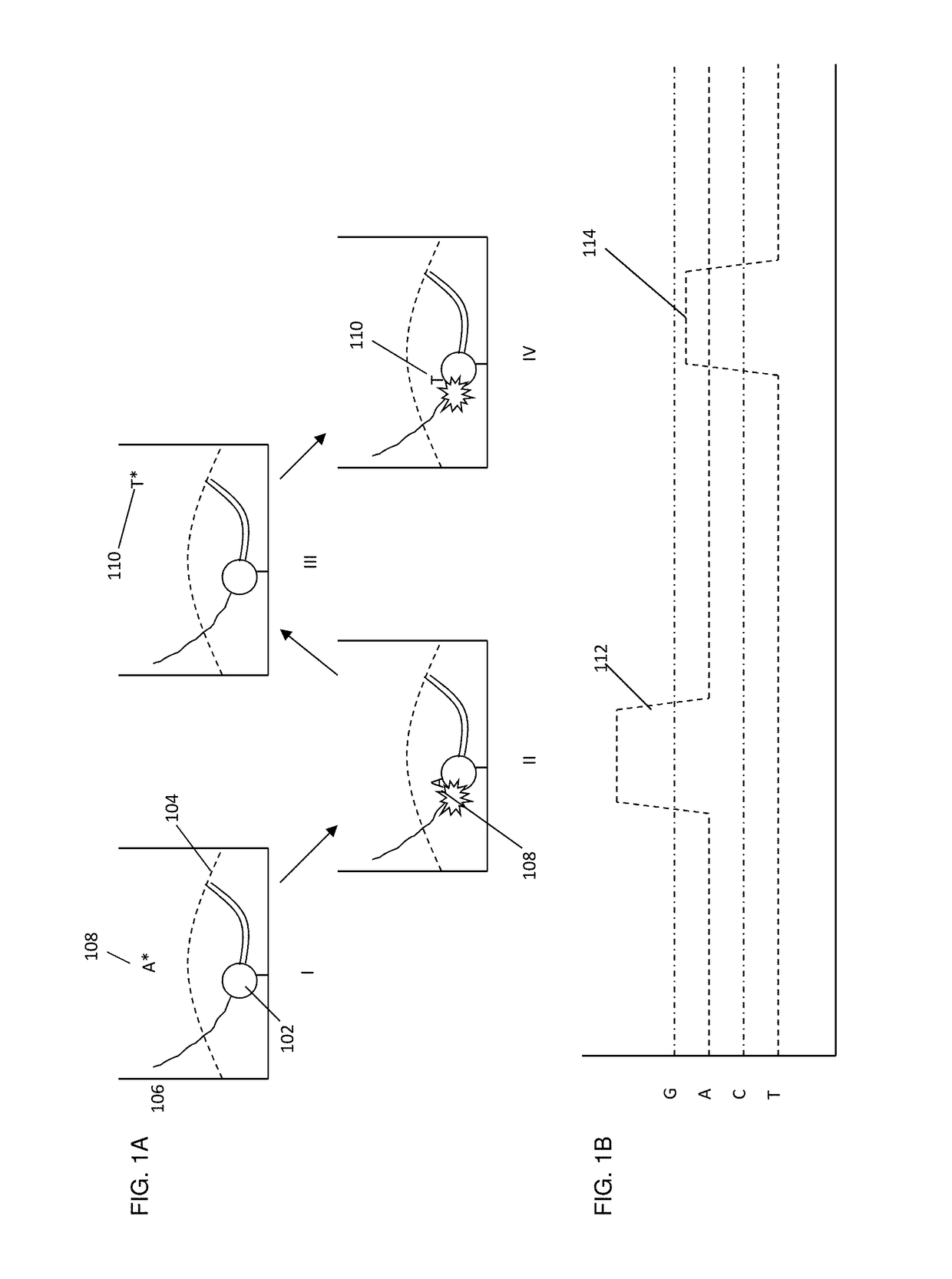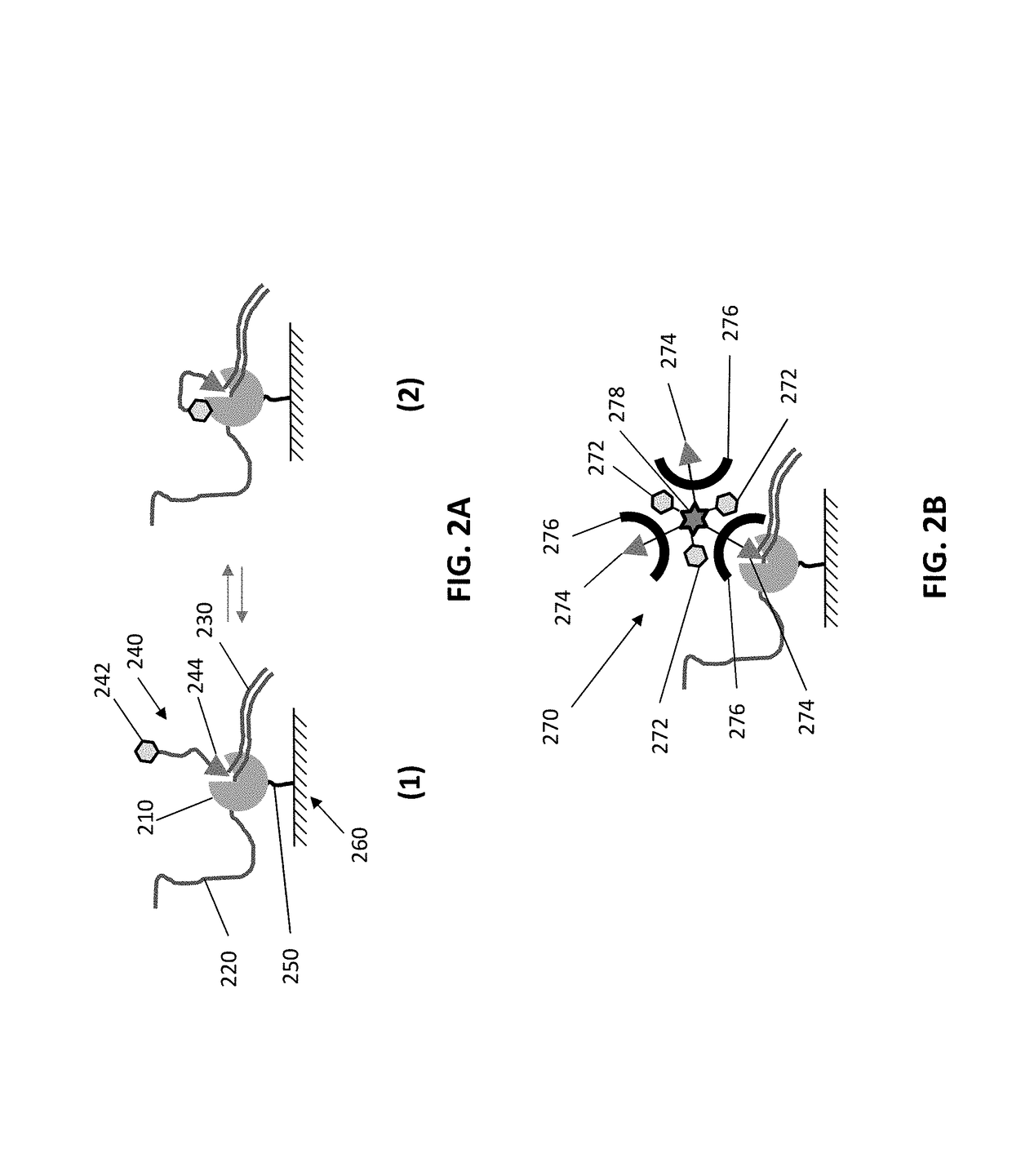Multimeric protected fluorescent reagents
a fluorescent reagent and multi-meric technology, applied in the field of multi-meric protected fluorescent reagents, can solve the problems of inflicting damage on other components of the reaction mixture, damage is particularly problematic, reaction mixtures may be exposed to excitation radiation,
- Summary
- Abstract
- Description
- Claims
- Application Information
AI Technical Summary
Benefits of technology
Problems solved by technology
Method used
Image
Examples
example 1
of Protected Fluorescent Reagent Compounds Comprising Multivalent Fluorescent Dye Elements
[0334]Three different protected fluorescent reagent compounds comprising tetravalent fluorescent core elements were synthesized according to the following experimental procedures, as outlined in FIGS. 7-9.
Tetracarboxy Carbocyanine Dye (D010)
[0335]A solution of 1-(3-sulfonatopropyl)-2,3,3-trimethylindoleninium-5-carboxylate (85.4 mg, 231 umol, prepared from 1-hydrazinylbenzene-1,3-dicarboxylic acid in 2 steps following the standard Fischer indole synthesis procedures) and ortho-triethylformate (300 μL) in pyridine was heated at 100° C. overnight under nitrogen. Solvent was evaporated off under reduced pressure to give a dark red residue, which was then purified by reverse-phase HPLC (acetonitrile / 0.1 M TEAB gradient) to give 122 μmole of the product (53% yield). λmax (545 nm).
Tetraalkyne Carbocyanine Dye (D010-(PA)4)
[0336]To a solution of the tetracarboxy dye, D010 (10 μmol) in DMF (300 μL) was ...
example 2
of Protected Fluorescent Reagent Compounds Comprising Non-Fluorescent Multivalent Core Elements
[0343]Protected fluorescent reagent compounds comprising non-fluorescent multivalent core elements were synthesized according to the following experimental procedures. In particular, the non-fluorescent central core was synthesized as outlined in Scheme 16, the dye reagents were prepared as outlined in Scheme 17, and the dyes were attached to the central core as outlined in Schemes 18 and 19.
3,3′,3″-(benzene-1,3,5-triyltris(oxy))tris(propan-1-amine) (2-1b)
[0344]NaH (108 mg, 4.5 mmol) was added to Phloroglucinol (126 mg, 1 mmol) DMF solution slowly, then tert-butyl (3-chloropropyl)carbamate (935 mg, 4.5 mmol) was added and heated to 55° C. overnight. The resultant solution was diluted in 30 mL ethyl acetate, washed with 20 mL water 4 times. Organic layer was collected, after evaporating the solvent, the residue was further purified with silica gel column to afford 146 mg product 2-1a (24% y...
example 3
of Alternative Protected Fluorescent Reagent Compounds Comprising Non-Fluorescent Multivalent Core Elements
[0356]Alternative protected fluorescent reagent compounds comprising non-fluorescent multivalent core elements were synthesized according to the following experimental procedures. In particular, the non-fluorescent core was synthesized as outlined in Scheme 20. The dye reagents were attached to the non-fluorescent core as described in the experimental methods, and the final products were assembled using click reactions as outlined in FIG. 10.
4-(3-Aminopropyl)-N-[3,5-bis({[4-(3-aminopropyl)-3,5-bis(hex-5-yn-1-yloxy)benzene]amido})cyclohexyl]-3,5-bis(hex-5-yn-1-yloxy)benzamide, (NH2—Sb2)3-Chx, “CS2 core”, 3-4)
[0357]BOP (35.4 mg, 80 μmol) was added to a vial containing 4-(3-{[(tert-butoxy)carbonyl]amino}propyl)-3,5-bis(hex-5-yn-1-yloxy)benzoic acid (3-1), (77.8 mg, 165 μmol), cyclohexane-1,3,5-triamine (3-2), (5.2 mg, 40 μmol) and DIEA (28 μL). After stirring for 45 min at room te...
PUM
| Property | Measurement | Unit |
|---|---|---|
| pH | aaaaa | aaaaa |
| pH | aaaaa | aaaaa |
| pH | aaaaa | aaaaa |
Abstract
Description
Claims
Application Information
 Login to View More
Login to View More - R&D
- Intellectual Property
- Life Sciences
- Materials
- Tech Scout
- Unparalleled Data Quality
- Higher Quality Content
- 60% Fewer Hallucinations
Browse by: Latest US Patents, China's latest patents, Technical Efficacy Thesaurus, Application Domain, Technology Topic, Popular Technical Reports.
© 2025 PatSnap. All rights reserved.Legal|Privacy policy|Modern Slavery Act Transparency Statement|Sitemap|About US| Contact US: help@patsnap.com



